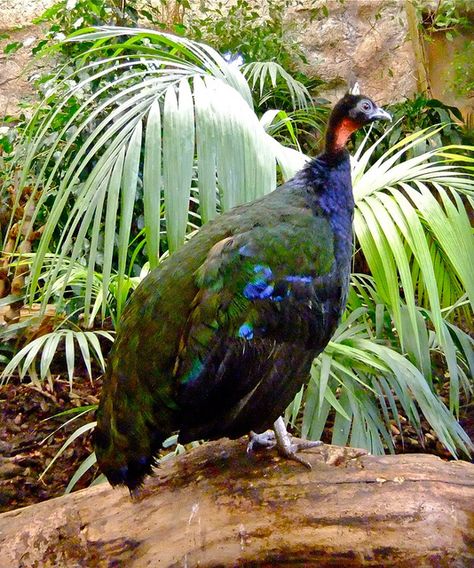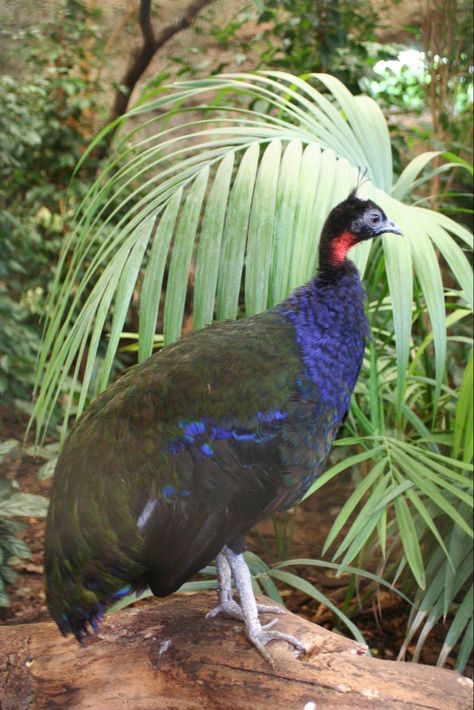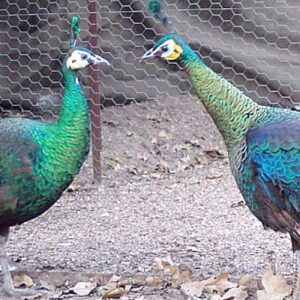The Congo Peafowl (Afropavo congensis) is a remarkable and elusive bird species native to the dense rainforests of the Congo Basin in Central Africa. It is the only peafowl species found in Africa and is closely related to pheasants, rather than its Asian counterparts, the Indian and Green Peafowls. Discovered relatively recently in 1936, the Congo Peafowl is an important symbol of Africa’s rich biodiversity and serves as a flagship species for conservation in its region. Both males and females have unique and distinctive characteristics that make them fascinating.
Physical Characteristics
Male Congo Peafowl:
The male Congo Peafowl is smaller and more subtly colored compared to the Asian peafowls but no less striking:
- Plumage: Males have deep blue-green plumage with a metallic sheen that shimmers in light. The chest and neck feathers are iridescent, giving them a regal appearance.
- Tail: Unlike the long train of Asian peafowls, the Congo Peafowl male has a short, rounded chestnut-colored tail.
- Crest: The head is adorned with a small but distinct crown of upright white feathers, enhancing its elegant look.
- Size: Males are approximately 64–70 cm (25–28 inches) in length, with a robust build and long legs suited for traversing the forest floor.
Female Congo Peafowl:
The female is more subdued in appearance, designed for camouflage in the dense forest undergrowth:
- Plumage: Females are predominantly brown with a mix of chestnut and subtle green iridescence on the neck and upper body. This muted coloration helps them blend into their surroundings, especially during nesting.
- Crest: Like the male, the female also has a small crest, but it is less prominent.
- Size: Slightly smaller than the male, females measure around 60–63 cm (24–25 inches) in length.
Both males and females have long legs and strong feet, adapted for navigating the dense forest floor where they spend most of their time.
Habitat and Distribution
The Congo Peafowl is endemic to the rainforests of the Congo Basin, including parts of the Democratic Republic of Congo (DRC). It thrives in dense, humid lowland forests, often near rivers or swampy areas. Its elusive nature and preference for thick undergrowth make it challenging to observe in the wild.
Behavior and Social Traits
The Congo Peafowl is a secretive and mostly ground-dwelling bird, spending much of its time foraging in the forest undergrowth.
- Activity: They are primarily crepuscular, meaning they are most active during dawn and dusk.
- Diet: Their diet is omnivorous and includes fruits, seeds, insects, and small invertebrates. This varied diet helps them play a role in seed dispersal and pest control within their ecosystem.
- Social Structure: Congo Peafowls are generally solitary or found in pairs, with males and females coming together primarily during the breeding season.
Reproduction and Breeding
The Congo Peafowl’s breeding habits reflect their forest-dwelling lifestyle:
- Courtship Displays: The male performs a subtle courtship display, fanning out its short tail and puffing up its iridescent chest feathers while making soft vocalizations to attract the female.
- Nesting: The female builds a shallow nest on the ground, hidden among dense vegetation for protection from predators.
- Eggs and Chicks: She typically lays 2–4 eggs per clutch, which she incubates for about 26–28 days.
- Parental Care: The chicks are precocial, able to walk and forage shortly after hatching, but they rely on the female for guidance and protection.
Vocalizations
Congo Peafowls are vocal birds, with males producing low-frequency calls to communicate or assert dominance, while both sexes use softer calls for communication within pairs. Their calls are vital in dense forests where visibility is limited.
Conservation Status
The Congo Peafowl is listed as Vulnerable by the IUCN due to habitat loss, hunting, and human encroachment. Its restricted range and dependence on dense forest habitats make it particularly susceptible to deforestation and fragmentation caused by agriculture, logging, and mining.
Conservation efforts include habitat protection, anti-poaching measures, and awareness campaigns to highlight the bird’s ecological and cultural importance. Captive breeding programs are also in place to ensure the species’ survival.
Cultural and Ecological Significance
The Congo Peafowl holds symbolic value as a representative of Africa’s unique biodiversity. It plays a crucial role in its ecosystem by dispersing seeds and controlling insect populations. As an indicator species, its health reflects the overall condition of its rainforest habitat, emphasizing the need for conservation.
Conclusion
The Congo Peafowl (Afropavo congensis) is a rare and extraordinary bird, embodying the beauty and fragility of Africa’s tropical rainforests. Its shimmering plumage, elusive nature, and ecological importance make it a fascinating subject for study and conservation. Protecting this species and its habitat is vital not only for the survival of the Congo Peafowl but also for the rich biodiversity of the Congo Basin.









Reviews
There are no reviews yet.